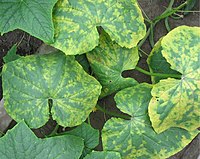
Photo from wikipedia
Ranunculus (Ranunculus asiaticus L.) is one of the most popular cut flowers in Japan. However, the infection rate of ranunculus mild mosaic virus (RanMMV) in ranunculus plants has been gradually… Click to show full abstract
Ranunculus (Ranunculus asiaticus L.) is one of the most popular cut flowers in Japan. However, the infection rate of ranunculus mild mosaic virus (RanMMV) in ranunculus plants has been gradually increasing during cultivation, suggesting that RanMMV may be transmitted from weeds to ranunculus plants in cultivation fields. In our survey, RanMMV in R. japonicus, R. tachiroei, R. cantoniensis, Geranium carolinianum, Vicia sativa, V. tetrasperma, and V. hirsute in ranunculus fields and noncultivation regions in Japan was detected. Ranunculaceae weeds grow all year in cultivation fields, unlike R. asiaticus, indicating that these weeds may be a source of RanMMV infection. In addition, a pairwise comparison of CP genes between RanMMV isolates taken from R. asiaticus, R. japonicus, and R. tachiroei showed high nucleotide (98.1%-100%) and amino acid (98.5%-100%) identities. These results support the hypothesis that RanMMV may be transmitted between Ranunculaceae weeds and R. asiaticus plants. Thus, virus control should focus on removing host weeds from the cultivation fields.
Journal Title: Letters in applied microbiology
Year Published: 2021
Link to full text (if available)
Share on Social Media: Sign Up to like & get
recommendations!